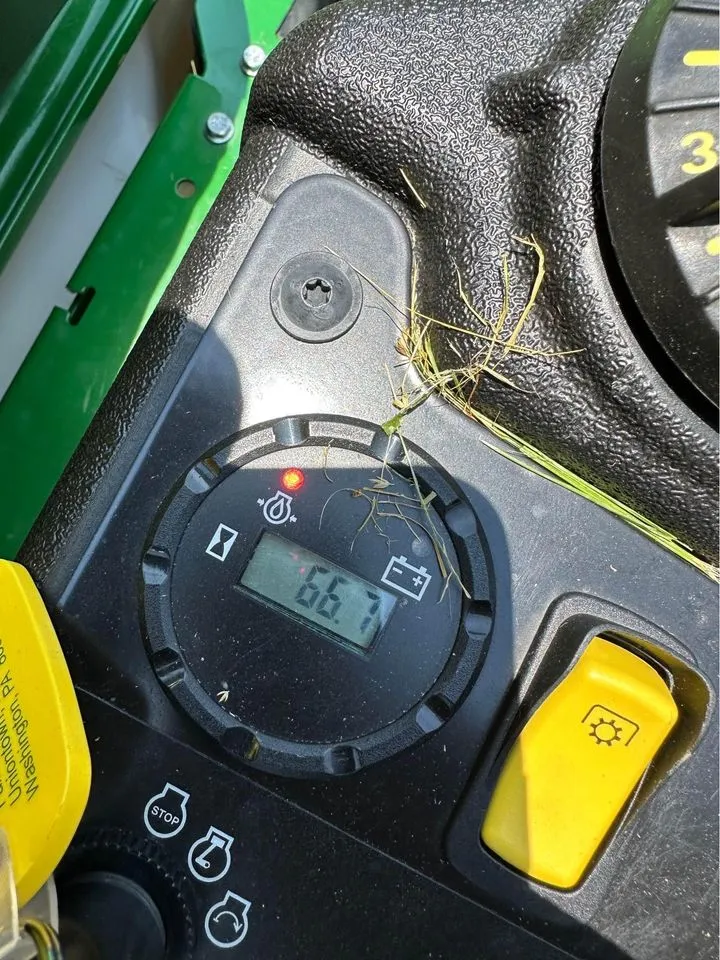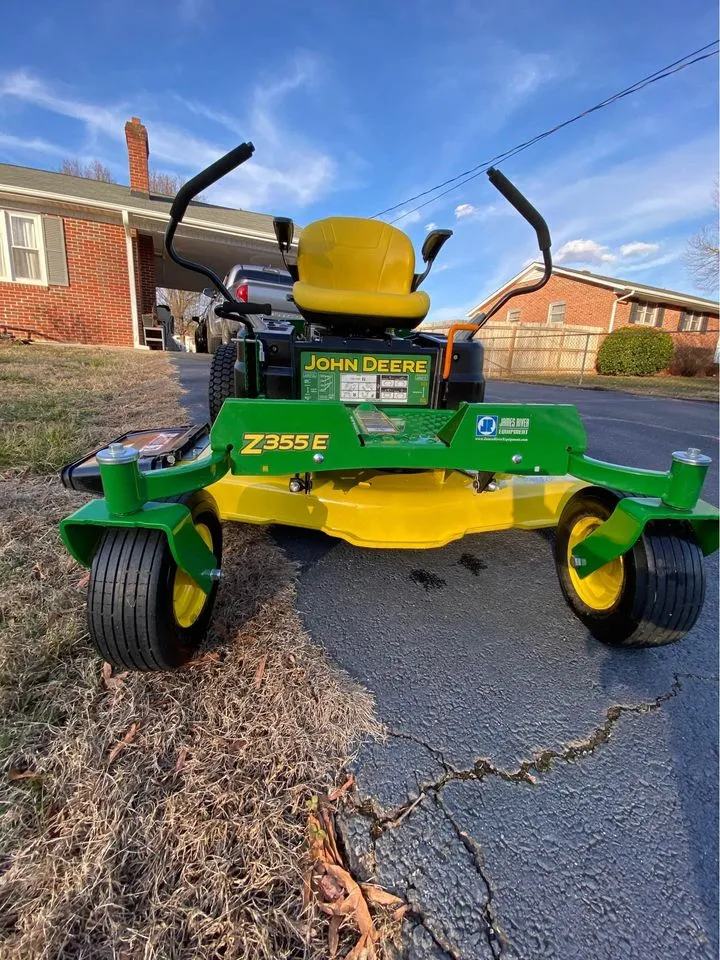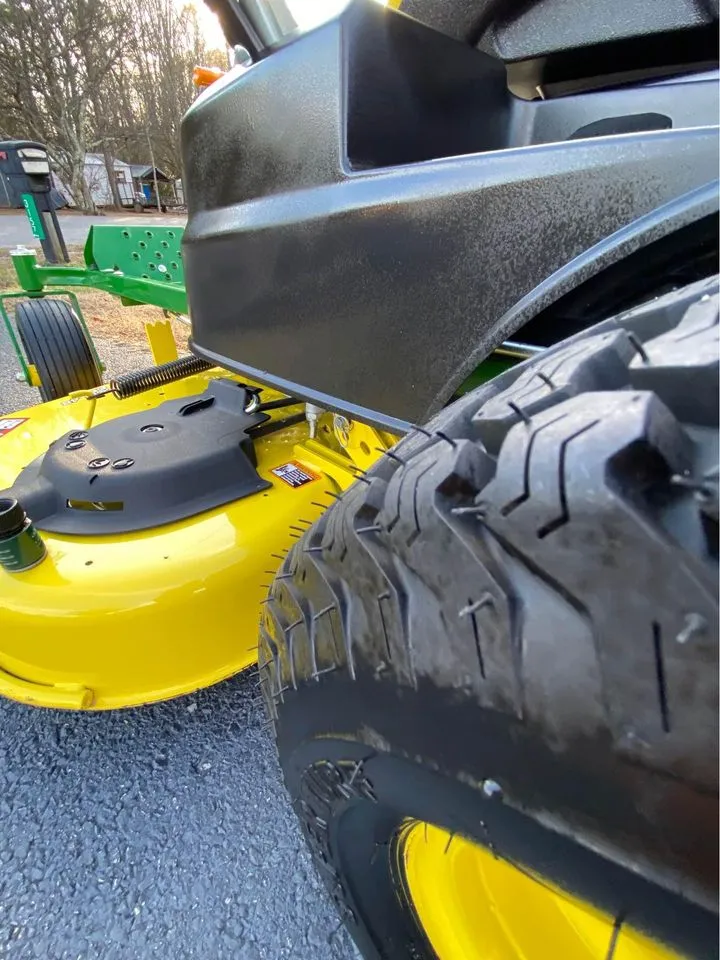Starting a John Deere zero turn mower requires precision and knowledge for both optimal performance and safety.
As a seasoned landscaping professional with extensive experience in operating and maintaining a variety of mowers, I understand the intricacies of these machines.
My expertise will guide you through the necessary steps to start your mower effectively, ensuring a seamless mowing session.
Trust in this guide as it provides you with the essential information needed to harness the full potential of your John Deere zero turn mower.
Let’s dive straight into the process, and I’ll show you how to get your mower up and running with confidence and ease.
Quick Summary
- To start a John Deere zero turn mower, engage the parking brake, set the throttle and choke, and then turn the ignition key, following any specific model-related instructions.
- Regular maintenance, including checking the fuel, spark plug, battery, and air filter, is crucial, especially after long storage periods or seasonal changes.
- A study by the outdoor power equipment Institute suggests that routine maintenance can extend the lifespan of mowing equipment by up to 50%.
- In my experience, the ease of troubleshooting and maintaining a John Deere zero turn mower significantly reduces downtime and enhances overall efficiency.
How to Start a John Deere Zero Turn: Step By Step
Owning a John Deere zero turn mower and knowing how to start it properly is crucial for its operation. It’s not just about turning a key; there’s a proper sequence to follow to ensure it fires up correctly.
Starting Procedure
Now that I’m familiar with the controls of my John Deere zero turn mower, it’s time to get it up and running.
I’ll walk you through the straightforward steps to start the mower, ensuring a smooth beginning to your lawn care session.
Step-by-Step Instructions
Make sure the parking brake is engaged to prevent any unintended movement.
Then, I adjust the throttle and choke positions before finally turning the ignition key to bring the machine to life.
Engaging the Brake
To ensure the John Deere zero turn mower remains stationary during startup, it’s critical to engage the brake.
- Brake Maintenance: Regularly check for wear and proper function.
- Clutch Operation: Ensure smooth engagement for safety.
- Brake System Overview: Familiarize myself with its components.
- Parking Brake Adjustment: Adjust as needed for reliable engagement.
- Brake Safety Features: Verify they’re operational before starting.
Setting Throttle and Choke Positions
Having engaged the brake to ensure stability, I’ll next set the throttle and choke to the appropriate positions to start my John Deere zero turn mower.
I understand choke function is crucial for a cold start, so I’ll pull it fully for engine warm-up. Throttle adjustment comes next, taking seasonal considerations into account to ensure the mower starts smoothly and is ready for operation.
Turning the Ignition Key

With the brake engaged and the throttle and choke set, I now turn the ignition key to start my John Deere zero turn mower.
- Regular ignition maintenance ensures reliability
- Have a key replacement on hand to avoid delays
A well-maintained electrical system is crucial. Battery care extends life and performance. Check the starter solenoid for consistent starts.
Also Read: How to Bypass Ignition Switch on Riding Mower
What to Do if the Mower Doesn’t Start on the First Try
If your John Deere zero turn mower doesn’t roar to life on the initial attempt, don’t panic; there are a few checks and steps to troubleshoot the issue.
First, I’ll make sure the fuel quality is up to par; bad gas can hinder starting.
Next, I’d take a peek at the spark plug to see if it’s in good condition and properly connected.
No luck yet? Then it’s time to check the battery charge—without enough juice, the starter motor won’t turn over.
Finally, I’d examine all the electrical connections to ensure they’re secure and corrosion-free.
Addressing these potential culprits one by one usually sets me right back on track to getting my mower started.
Related: How to Move a John Deere Zero Turn Mower That Won’t Start
Post-Start Checks
Once I’ve got my John Deere zero turn mower purring, I always take a moment to listen for any odd sounds or feel for unexpected vibrations. It’s crucial to make sure all the controls are working as they should before I set off.
Checking for Unusual Noises or Vibrations
These symptoms may require engine troubleshooting to ensure the longevity and performance optimization of your equipment. It’s crucial to address any anomalies promptly to prevent further complications.
Here’s what I keep an eye (and ear) out for:
- Whining or grinding sounds that suggest bearing issues
- Squealing belts indicating wear or improper tension
- Rattling, which might mean loose parts or debris
- Knocking noises from the engine requiring immediate attention
- Unusual vibrations pointing to imbalance or misalignment
Regular servicing is my go-to strategy for keeping my mower in top shape. I find that noise diagnosis and vibration analysis are key to maintaining a smooth, efficient operation.
Ensuring All Controls are Responding Correctly
After starting the mower, I immediately test all controls to ensure they’re operating smoothly and responsively. This isn’t just about engine priming; it’s about confirming that all systems are go.
I conduct response testing by gently manipulating the levers, checking for any lag or stiffness that might indicate a need for lever adjustment. It’s crucial that each control responds accurately to my input for precise maneuvering.
As I go through control calibration, I’m also mindful of operator comfort. The controls shouldn’t only work flawlessly but also allow me to maintain a relaxed posture without straining.
If I find any controls out of sync, I’ll pause to adjust them, ensuring my mowing session is as efficient and comfortable as possible.
Problems for New Users

Beginners may face challenges in starting the mower, such as dealing with an empty fuel tank or a faulty ignition system. Understanding the mower’s controls, including the seat adjustment lever, control levers, and key switch, is crucial.
Additionally, checking fuel and oil levels and familiarizing oneself with the mower’s functionalities as outlined in the operator’s manual can greatly help new users overcome initial difficulties
Tips for Efficient Operation
Now that I’ve got my John Deere zero turn mower humming, let’s focus on getting the best cut in the least amount of time.
Adjusting your mower’s settings to suit different turf conditions can also make a huge difference in efficiency and lawn health.
Electric Start System
For models equipped with an electric start system, it’s important to provide clear instructions on its use. This involves turning the ignition switch to the “ON” position and then pressing the electric start button.
If the mower fails to start, users should refer to troubleshooting tips in the owner’s manual. This system simplifies the starting process and enhances user convenience, especially for those less familiar with manual starting methods.
Maintenance Tips
I’ll cover the essentials of basic upkeep and when it’s time to let the pros step in for servicing.
Sticking to a maintenance schedule not only ensures longevity but also guarantees peak performance each time you start your mower.
Basic Maintenance to Keep the Mower in Good Condition

Regularly checking and replacing the oil is crucial for ensuring your John Deere zero turn mower runs smoothly and efficiently. Beyond that, there’s a handful of maintenance tasks I stick to that keep my mower in top-notch condition.
Here’s what I always keep on my checklist:
- Engine tuning: I make sure the engine is properly tuned up according to the manufacturer’s guidelines.
- Blade sharpening: Sharp blades are non-negotiable for a clean cut, so I sharpen the blades regularly.
- Air filter care: A clean air filter ensures the engine breathes easily; I check and replace it as needed.
- Tire pressure: Consistent tire pressure means even cuts, so I check the tires before each use.
- Battery maintenance: I keep the terminals clean and the battery charged, especially before the mowing season starts.
Schedule for Professional Servicing
In addition to these routine tasks, I also schedule annual professional servicing to ensure my John Deere zero turn mower operates at peak performance. Adhering to recommended service intervals is crucial, and I don’t skimp on professional inspections.
These experts spot issues I might miss, keeping my machine in top-notch condition and upholding my warranty considerations. I’ve learned that neglecting these aspects can lead to voiding the manufacturer’s warranty, which is a risk I’m not willing to take.
Dealer support has been invaluable, especially for seasonal maintenance as they understand the specific needs of my mower. Before the mowing season kicks off, I make sure to get that professional tune-up.
This proactive approach saves me time and money in the long run, ensuring a smooth start every time.
Advanced Troubleshooting Techniques
For more intricate issues that prevent the mower from starting or functioning properly, users need to be aware of potential problems like unbalanced or damaged mower blades, bad spindle housing bearings, or hydrostatic transmission issues.
Regular inspection and maintenance of these parts are essential. For example, replacing damaged blades and ensuring they are correctly balanced can prevent operational issues.
Additionally, checking for and removing any foreign material wrapped around the blade shaft is crucial. Users should also be aware of the signs of bad bearings in the spindle housing and replace them if worn.
Similarly, the health of the mower’s deck belt and pulleys should be monitored, replacing any that are worn or damaged.
Finally, keeping the mower clean and free of debris will enhance its performance and longevity. Understanding and addressing these advanced issues can significantly improve the mower’s efficiency and reduce the likelihood of operational problems.
Maintenance and Troubleshooting of Fuel Pump and Carburetor
Proper maintenance of the fuel pump and carburetor is vital for the smooth starting and running of the mower. Issues like a failing fuel pump, which is responsible for moving fuel to the carburetor, can prevent the engine from starting.
Similarly, a dirty carburetor can lead to startup problems due to restricted fuel flow or clogged internal parts. Regular maintenance and cleaning of these components are necessary to avoid such issues and ensure efficient operation.
Read More:
Safety Mechanisms and Their Importance
An essential aspect of starting a John Deere zero turn mower is understanding and utilizing its safety features, such as the emergency brake and drive lever safety mechanism.
These features are crucial for preventing unintentional movements during startup.
The emergency brake, typically located on the bottom left or upper right side depending on the model, must be engaged in the safety position before the mower can start and operate.
Similarly, the drive levers need to be fully extended to enable the ignition process. This setup ensures that there are no sudden movements when the mower is started, safeguarding the user from potential accidents.
Our Verdict
After thoroughly navigating the start-up process of my John Deere zero turn mower, I can confidently say it’s a journey well worth taking. The initial safety measures and control familiarity that once seemed daunting are now instinctive parts of my routine.
Swiftly moving through post-start checks, I find myself mowing with an ease and efficiency I hadn’t experienced before.
Maintenance, which used to feel like a chore, has seamlessly woven itself into my regular schedule, contributing significantly to the mower’s durability.
Facing occasional troubleshooting challenges, I now see them as chances to enhance my skills and knowledge.
In conclusion, my experience with the John Deere zero turn mower has not only streamlined my lawn care process but also enriched my understanding of this efficient and reliable machine.
Frequently Asked Questions
Can I start my John Deere zero turn mower on a hill or uneven terrain, and if not, why?
I shouldn’t start my mower on a hill due to slope safety, stability concerns, and traction issues. The starting angle can strain the transmission. It’s best to begin on level ground for safety.
What should I do if my John Deere zero turn mower won’t start after being stored for the winter season?
If my mower won’t start after winter, I’ll check the fuel, maintain the battery, inspect the spark plug, verify the oil level, and clean the air filter to tackle any starting issues.
Are there any specific environmental or weather conditions under which I should avoid starting or operating my John Deere zero turn mower?
I avoid starting my mower in extreme cold to prevent cold start challenges, on wet grass to avoid slipping, in extreme heat for operational safety, at high altitudes due to performance issues, and when frost risks damage.
If I lose the key to my John Deere zero turn mower, what are my options for starting it?
If I lose my key, I’ll consider a key replacement, ignition bypass, or locksmith services. Aftermarket solutions or electrical troubleshooting might also work, but I’ll ensure they’re safe before proceeding.
How does the use of ethanol-blended fuels affect the starting and operation of my John Deere zero turn mower?
Ethanol impacts my mower’s engine compatibility, often affecting fuel stability. I’ve noticed performance effects and realize maintenance considerations are crucial to prevent starting issues with ethanol-blended fuels in my John Deere.


